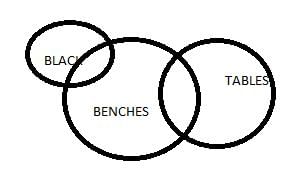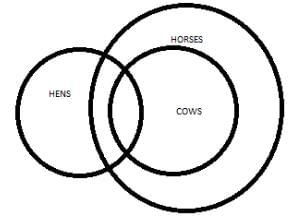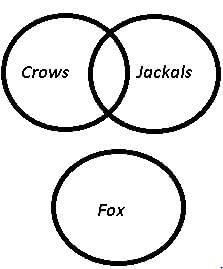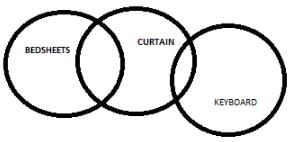Test: Syllogism- 3 - CLAT MCQ
20 Questions MCQ Test Logical Reasoning for CLAT - Test: Syllogism- 3
Directions : In each question below are given two Statements: followed by two conclusion numbered I and II. You have to take the two given statement to be true even if they seem to be at variance with commonly known facts and then decide which of the given Conclusions: logically follows from the two given statement, disregarding commonly know facts.
Statements:
Some benches are tables.
No table is black.
Conclusions:
I. Some tables are benches.
II. No bench is black.
Directions : In each question below are given two Statements: followed by two conclusion numbered I and II. You have to take the two given statement to be true even if they seem to be at variance with commonly known facts and then decide which of the given Conclusions: logically follows from the two given statement, disregarding commonly know facts.
Statements:
All gardens are trees.
Some trees are butterflies.
Conclusions:
I. Some gardens are butterflies.
II. Some butterflies are trees
| 1 Crore+ students have signed up on EduRev. Have you? Download the App |
Directions : In each question below are given two Statements: followed by two conclusion numbered I and II. You have to take the two given statement to be true even if they seem to be at variance with commonly known facts and then decide which of the given Conclusions: logically follows from the two given statement, disregarding commonly know facts.
Statements:
All pendrives are chalks.
All chalks are computers.
Conclusions:
I. All computers are pendrives.
II. All pendrives are computers
Directions : In each question below are given two Statements: followed by two conclusion numbered I and II. You have to take the two given statement to be true even if they seem to be at variance with commonly known facts and then decide which of the given Conclusions: logically follows from the two given statement, disregarding commonly know facts.
Statements:
Some children are flowers.
Some flowers are novels.
Conclusions:
I. Some children are novels.
II. No child is a flower.
Directions : In each question below are given two Statements: followed by two conclusion numbered I and II. You have to take the two given statement to be true even if they seem to be at variance with commonly known facts and then decide which of the given Conclusions: logically follows from the two given statement, disregarding commonly know facts.
Statements:
Some hens are cows.
All cows are horses.
Conclusions:
I. Some horses are hens.
II. Some hens are horses
Directions : In each question below are given two Statements: followed by two conclusion numbered I and II. You have to take the two given statement to be true even if they seem to be at variance with commonly known facts and then decide which of the given Conclusions: logically follows from the two given statement, disregarding commonly know facts.
Statements:
Some poets are producers.
Some producers are trees.
Conclusions:
I. Some poets are trees.
II. Some trees are producers.
Directions : In each question below are given two Statements: followed by two conclusion numbered I and II. You have to take the two given statement to be true even if they seem to be at variance with commonly known facts and then decide which of the given Conclusions: logically follows from the two given statement, disregarding commonly know facts.
Statements:
All roads are poles.
No pole is a house.
Conclusions:
I. Some roads are houses
II. Some houses are poles.
Directions : In each question below are given two Statements: followed by two conclusion numbered I and II. You have to take the two given statement to be true even if they seem to be at variance with commonly known facts and then decide which of the given Conclusions: logically follows from the two given statement, disregarding commonly know facts.
Statements:
All novels are pencils.
All pencils are flowers.
Conclusions:
I. All novels are flowers
II. Some pencils are not book.
Directions : In each question below are given two Statements: followed by two conclusion numbered I and II. You have to take the two given statement to be true even if they seem to be at variance with commonly known facts and then decide which of the given Conclusions: logically follows from the two given statement, disregarding commonly know facts.
Statements:
Some crows are jackals.
No fox is crow.
Conclusions:
I. Some jackals are foxes.
II. Some jackals are not foxes.
Directions : In each question below are given two Statements: followed by two conclusion numbered I and II. You have to take the two given statement to be true even if they seem to be at variance with commonly known facts and then decide which of the given Conclusions: logically follows from the two given statement, disregarding commonly know facts.
Statements:
Some curtains are bed sheets.
Very few keyboards are curtains.
Conclusions:
I. Some bed sheets are keyboards.
II. No curtains are keyboard.
Directions : In each question below are given two Statements: followed by two conclusion numbered I and II. You have to take the two given statement to be true even if they seem to be at variance with commonly known facts and then decide which of the given Conclusions: logically follows from the two given statement, disregarding commonly know facts.
Statements:
All radios are electric goods.
All table lamps are electric goods.
Conclusions:
I. Some radios are table-lamps.
II. Some tables-lamps are radios.
Directions : In each question below are given two Statements: followed by two conclusion numbered I and II. You have to take the two given statement to be true even if they seem to be at variance with commonly known facts and then decide which of the given Conclusions: logically follows from the two given statement, disregarding commonly know facts.
Statements:
Men are sinners.
Saints are men.
Conclusions:
I. Saints are sinners.
II. Sinners are saints
Directions : In each question below are given two Statements: followed by two conclusion numbered I and II. You have to take the two given statement to be true even if they seem to be at variance with commonly known facts and then decide which of the given Conclusions: logically follows from the two given statement, disregarding commonly know facts.
Statements:
A graduate is a man.
This thief is a graduate.
Conclusions:
I. This thief is a man.
II. Some men are thieves.
Directions : In each question below are given two Statements: followed by two conclusion numbered I and II. You have to take the two given statement to be true even if they seem to be at variance with commonly known facts and then decide which of the given Conclusions: logically follows from the two given statement, disregarding commonly know facts.
Statements:
All gases are solids.
All solids are liquids.
Conclusions:
I. All gases are liquids.
II. At least some liquids are solids.
In each of the questions below are given three statements followed by three or more conclusions. You have to take the given statements to be true even if they seem to be at variance with the commonly known facts.
Statements:
Some ducks are canes.
Some canes are books.
All books are lanterns.
Conclusions:
I. Some lanterns are canes.
II. Some lanterns are ducks.
III. All canes are lanterns.
IV. All ducks are lanterns.
In each of the questions below are given three statements followed by three or more conclusions. You have to take the given statements to be true even if they seem to be at variance with the commonly known facts.
Statements:
All markers are black.
All needles are black.
All toys are black.
Conclusions:
I. Some needles are markers.
II. Some toys are markers.
III. All markers are toys.
IV. All black are markers.
In each of the questions below are given three statements followed by three or more conclusions. You have to take the given statements to be true even if they seem to be at variance with the commonly known facts.
Statements:
All stores are tents.
Some tents are stones.
All stones are walls.
Conclusions:
I. Some walls are stores.
II. Some walls are tents.
III. All stones are stores.
IV. All walls are stores.
In each of the questions below are given three statements followed by three or more conclusions. You have to take the given statements to be true even if they seem to be at variance with the commonly known facts.
Statements:
Some bricks are gates.
Some gates are roof.
All wheels are bricks.
Conclusions:
I. Some wheels are gates.
II. No gate is wheel
III. Some gates are bricks.
IV. All roof are bricks.
In each of the questions below are given three statements followed by three or more conclusions. You have to take the given statements to be true even if they seem to be at variance with the commonly known facts.
Statements:
All desks are benches.
No bench is chair.
All chairs are roads.
Conclusions:
I. Some roads are chairs.
II. No chair is desk.
III. No road is bench.
IV. Some desks are roads.
In each of the questions below are given three statements followed by three or more conclusions. You have to take the given statements to be true even if they seem to be at variance with the commonly known facts.
Statements:
All chains are cycles.
Some cycles are wheels.
All wheels are mirrors.
Conclusions:
I. Some cycles are mirrors.
II. Some wheels are cycles.
III. Some mirrors are cycles.
IV. All chains are wheels.
|
34 videos|85 docs|70 tests
|
|
34 videos|85 docs|70 tests
|


 some tables are benches, and some benches or all benches can be black.
some tables are benches, and some benches or all benches can be black.












